#whalebones silks and satins
Explore tagged Tumblr posts
Text
experiencing my daily thought: “living in a city isn’t so bad. it’s crowded and disgusting but there’s beautiful women you can see everywhere,” then realizing that was literally a take dandelion had. but he was right
32 notes
·
View notes
Text

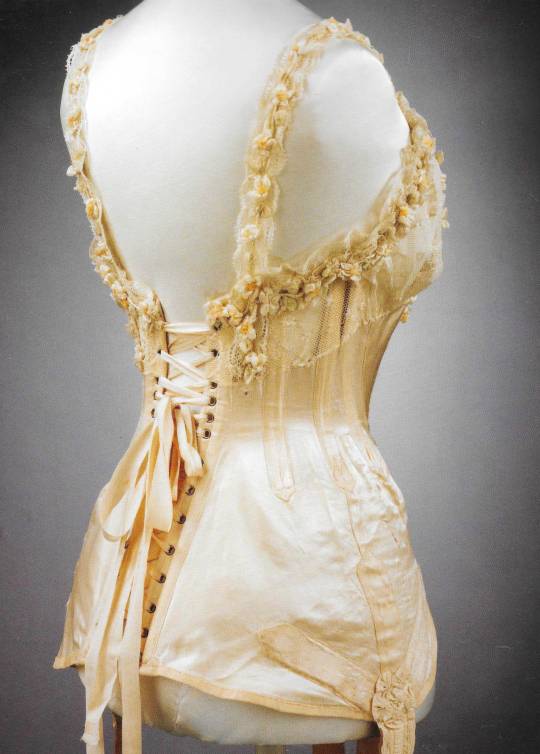
'wedding corset, silk satin + whalebone trimmed with machine lace + silk chiffon, british, 1905' in the wedding dress: 300 years of bridal fashions - edwina ehrman (2011)
269 notes
·
View notes
Text




'What some 17thC women wore: Bodice, made in England, 1630-1639 Silk satin, silk taffeta, canvas, buckram and whalebone, handsewn (V&A Museum, London)'
source: https://x.com/jdmccafferty/status/1766107704253124960?s=46&t=jRUUOuuZhwBih_P4ebqI0g
8 notes
·
View notes
Text
A Wedding Dress For Wednesday 💕
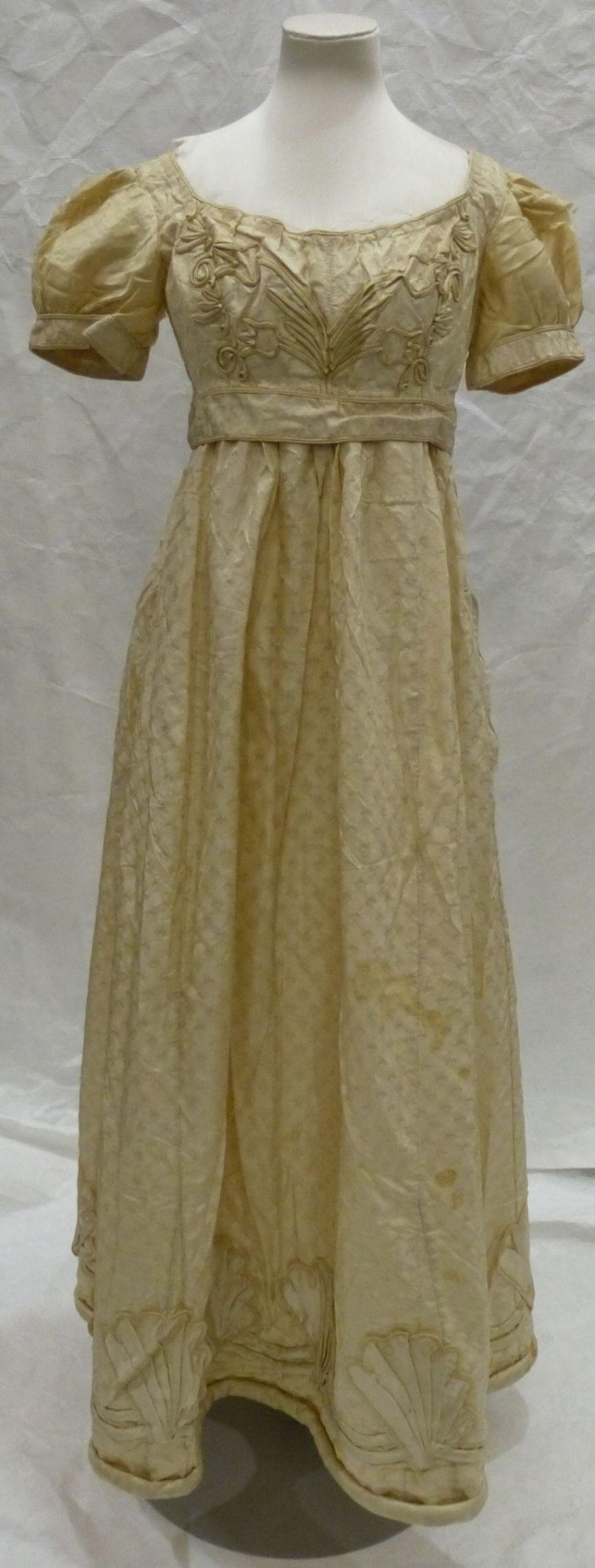
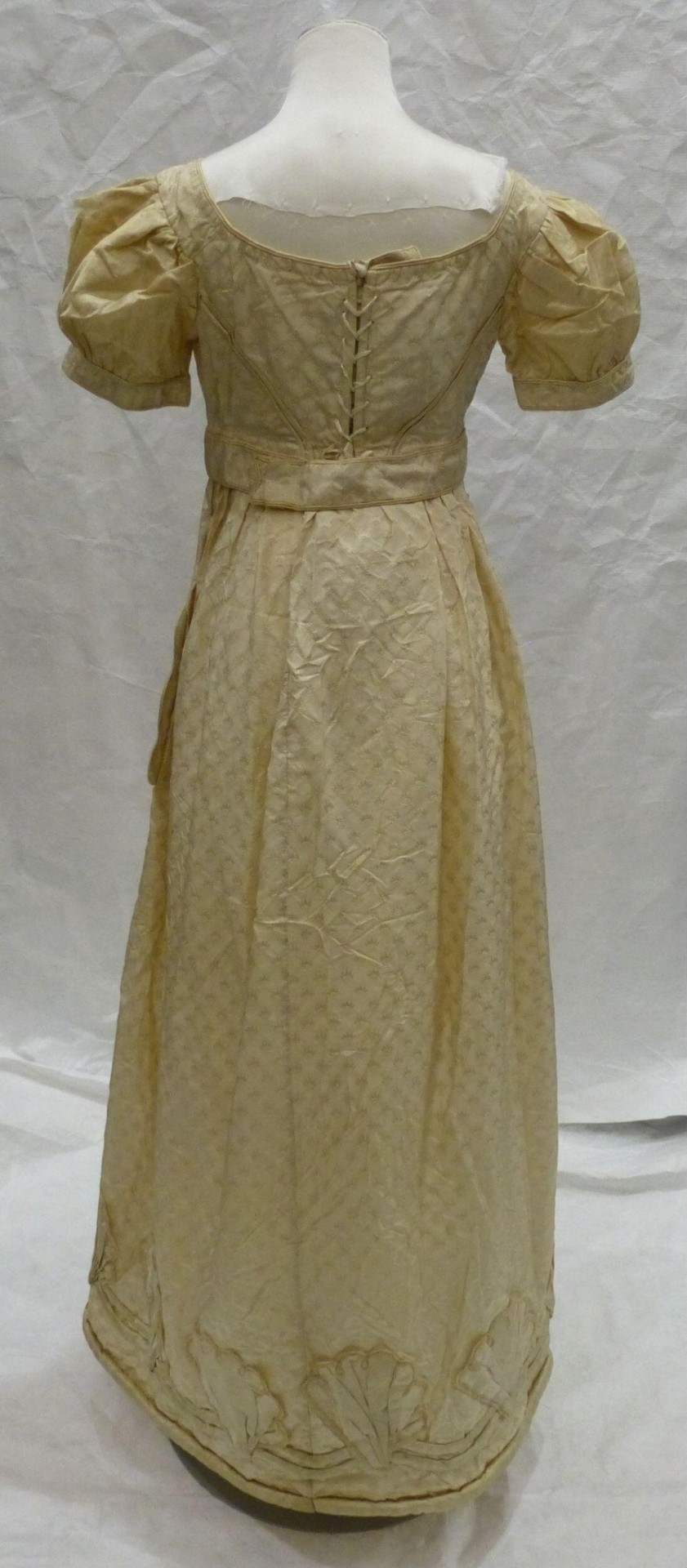
Wedding dress ca.1820-24 from the V&A collection.
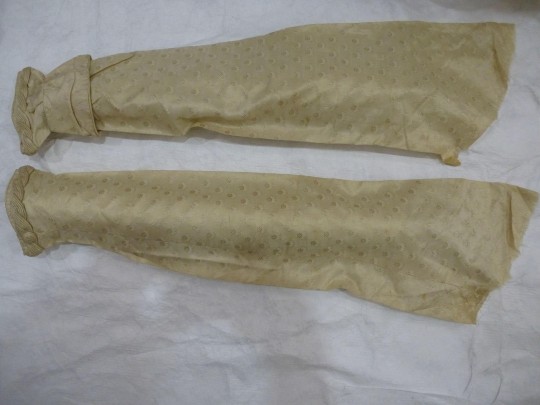
With detachable sleeves.
Description from the V&A website:
"Ivory figured silk wedding dress with shell motif applied onto the hem in cream silk-satin. The bottom of the skirt is also decorated with bands of padded silk satin, the bottom band forming the hem. There are two pockets on either side of the skirt, both edged with a scalloped border and silk-satin piping. The pocket on the left hand side is false and the pocket on the right is lined with lawn. The front of the bodice is decorated with applied silk satin forming a floral pattern. The back is fastened with corset-style silk ribbon lacing, threaded through eyelets reinforced with silk thread. Two vertical strips of whalebone on either side of the fastenings provide support. Beneath the lacing is a figured silk placket to hide the chemise or underdress. The waistband is made of figured silk edged with silk satin and is fastened with a hook and eye. The puffed sleeves are made of plain cream silk edged with a border of figured silk and silk-satin piping.
The bodice of the dress is lined with cotton and has a drawstring on the inside front of the neck for elevating the neckline. The skirt is unlined.
Separate sleeves of ivory figured silk with braided silk satin piping applied around the wrist."
3 notes
·
View notes
Text

January 9, 1982 - Buffalo Evening News Fashion Inspiration From 1700s By CATHERINE SMITH NEW YORK -- No woman today deliberately setBlass, Albert Capraro, Oscar de la Renta, Gene Ewing, Mary McFadden, Morton Myles, Albert Nipon, Mollie Parnis, Arnold Scaasi and Helen Sideles of the 1700s are on display now in another glittering presentation by Diana Vreeland at the The Metropolitan Museum of Art, New York's Costume Institute in New York City. Women of that time are especially remembered for "sacque dresses," tightly fitted and decollete on top and voluminous through the skirt. Sometimes a train fell from the back neckline of the dress over the pouffed skirt for even more volume. To make the skirts stand out, side paniers came into fashion. These embroidered or decorated skirt panels, were made to stand out by underconstruction of wood or whalebone tied at the waist. Louise Esterhazy has written in Women's Wear Daily that she 's been "18th-centuryed half to death" but most people seem to be enjoying Diana Vreeland's show. Mrs. Vreeland, a longtime editor of Vogue, is an admirer of that time because she says women then emerged from "domestic bondage" to take their places in cities and become "powers behind the throne" as well as leaders of their own intellectual salons. Fashions from France dominate the show but there are also clothes from Sweden, England, Italy, and America, as well as accessories, including a reproduction of the so-called "Queen's Necklace," with 637 diamonds, which is supposed to have hastened the French revolution. The 18th century clothes even have some modern descendants, the Cameo Collection. Merle Norman cosmetics, sponsor for the costume institute show, also commissioned 10 of today's leading designers to do clothes inspired by the 18th century garments. The Cameo Collection includes work by Bill Blass, Albert Capraro, Oscar de la Renta, Gene Ewing, Mary McFadden, Morton Myles, Albert Nipon, Mollie Parnis, Arnold Scaasi and Helen Sidel. Most of their designs are done in opulent fabrics: satin, taffeta, velvet, brocade, lace. There are many of the to-be-expected full skirts, tight bodices and flowing sleeves. Mary McFadden's design even includes her version of side paniers to make the skirt stand out. A book entitled "The Eighteenth Century Woman," is slated to be published in April, 1962, by Doubleday. The text was written by historian Olivier Bernier, and it was edited by Jacqueline Kennedy Onassis. DRAMA AND OPULENCE of the 18th century captured by designer Albert Capraro in his "blush rose" silk taffeta gown with full, full skirt and deep v-neck. Part of the Cameo Collection.
0 notes
Text
From Victorian to Modern: The Evolution of Gothic Corsets
The gothic corset, an emblem of dark elegance and subversive fashion, has a rich history that spans centuries. Its evolution from Victorian-era undergarment to a symbol of modern alternative culture reveals the dynamic interplay between fashion, societal norms, and personal expression. Let’s take a journey through time to explore how the gothic corset transformed from a utilitarian foundation piece into a bold statement of individuality.
The Victorian Roots of Corsetry
In the Victorian era (1837–1901), corsets were integral to women’s wardrobes. Designed to shape the waist and support voluminous skirts, they emphasized an hourglass figure—a silhouette synonymous with femininity and refinement.
Features of Victorian Corsets:
Materials: Primarily made of cotton, silk, or satin, reinforced with steel or whalebone for structure.
Design: High backs and long fronts to support posture and smooth the torso.
Function: Served as an undergarment, hidden beneath layers of dresses and petticoats.
While corsets were not inherently gothic, the dark, ornate aesthetics of the Victorian period laid the groundwork for their association with gothic fashion. Black lace, brocade fabrics, and the moody undertones of mourning attire became inspirations for later gothic styles.
The Edwardian Era and the Decline of Corsetry
The early 20th century marked a shift in corsetry. Edwardian corsets (1901–1910) introduced the "S-bend" silhouette, which pushed the bust forward and hips back, creating a dramatic curve. However, by the 1920s, corsets fell out of favor due to changing societal norms and the rise of flapper fashion, which embraced looser, more androgynous shapes.
This decline set the stage for corsets to transition from everyday essentials to symbols of rebellion, eventually finding their place in gothic culture.
Corsets in Gothic Revival Movements
The gothic revival of the late 20th century reimagined corsets as powerful symbols of alternative identity. Subcultures like goth, punk, and fetish communities embraced waist training corset for their dramatic and subversive qualities.
Gothic Corsets in the 1970s and 1980s:
Inspired by Victorian and Edwardian designs, gothic corsets became statement pieces rather than hidden undergarments.
Black leather, PVC, and lace replaced traditional fabrics, creating a darker, edgier aesthetic.
Bands like Siouxsie and the Banshees and The Sisters of Mercy popularized gothic fashion, with corsets as iconic staples.
The Role of Fetish Wear:
Incorporating elements from fetish fashion, gothic corsets became tighter, shinier, and more daring. Lacing, studs, and dramatic embellishments added a rebellious edge that resonated with the gothic ethos of rejecting societal norms.
Modern Gothic Corsets: A Fusion of Styles
Today, gothic corsets are a blend of historical influences and contemporary innovation. They cater to diverse tastes, from romantic Victorian-inspired designs to bold, avant-garde creations.
Key Trends in Modern Gothic Corsets:
Materials: Velvet, brocade, leather, and lace remain popular, with the addition of modern fabrics like mesh and latex.
Designs: Incorporate steampunk, cyber goth, and fantasy elements, reflecting the evolution of gothic subcultures.
Accessibility: Mass production has made corsets more affordable, while bespoke options cater to enthusiasts seeking unique pieces.
Modern gothic vinyl corset are worn in various ways, from traditional pairings with long skirts to edgy combinations with leather pants or ripped jeans. They’re no longer confined to the goth scene, appearing in mainstream fashion, cosplay, and even bridal wear.
Cultural Significance of Gothic Corsets
Gothic corsets transcend mere fashion; they carry deep cultural and personal significance.
Empowerment: Wearing a corset is often seen as a statement of empowerment, allowing individuals to reclaim their bodies and express their identities.
Rebellion: Gothic corsets challenge societal norms, embracing the beauty of darkness, individuality, and nonconformity.
Artistry: Modern corset makers treat these garments as works of art, combining craftsmanship with creative storytelling.
The Enduring Allure of Gothic Corsets
The gothic corset journey from Victorian modesty to modern boldness reflects a fascinating evolution in both fashion and cultural attitudes. It has transitioned from being a tool of conformity to a beacon of self-expression.
For enthusiasts, the allure of the gothic corset lies not only in its striking appearance but also in goth in corset rich history and the sense of empowerment it offers. Whether worn for fashion, performance, or personal fulfillment, the gothic corset remains a timeless symbol of dark beauty and individuality.
As the world of fashion continues to evolve, one thing is certain: the gothic corset will always hold a special place in the hearts of those who embrace its mystique.
0 notes
Photo
You can indeed make a French corset for... *does math* $84.08! Or less, if you swap the double-faced silk satin ribbon for linen tapes, grosgrain ribbon, or jacquard weave trim. Many such economic corsets may be seen in museums, at auction, or in photographs of private collections. This article may disapprove, but it'd be a good idea for a wearable mock-up. While the price of beautiful ribbon has nearly halved when taking into account inflation, it's still a bit pricey. Plus the author expects you to already have whalebones, a busk, an a local leather-worker to punch the eyelets for you!
The pattern is for waist sizes from 20 to 26 inches. The instructions say to take out width from the side as needed, but I'll readily confess to having seen antique ribbon corsets use a full width of ribbon for the steels and extra boning at the front if you need to add some extra width and support. Have fun!

ca. 1900 French Corset pattern, along with a short article on a man who knows the meaning of life- practicality and humor all in one package! Instructions seem to be included but excellent eyesight will be required- this was as large as I could find it from a pay site.
35 notes
·
View notes
Photo
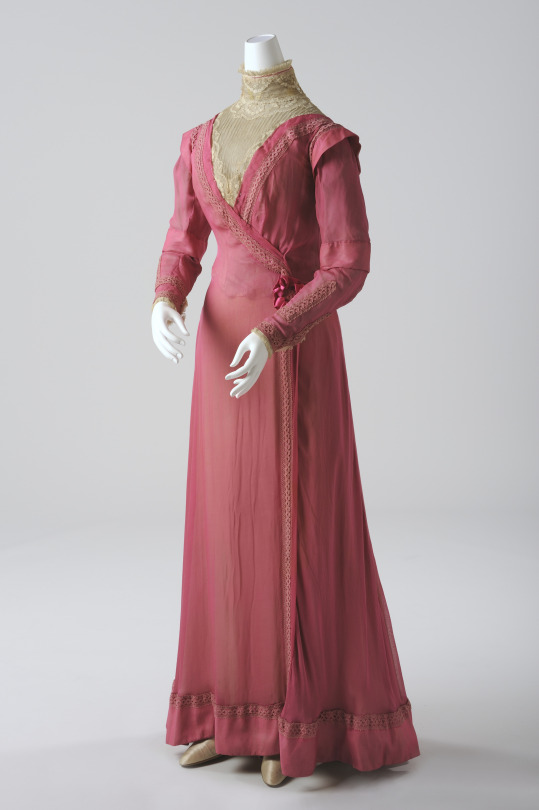
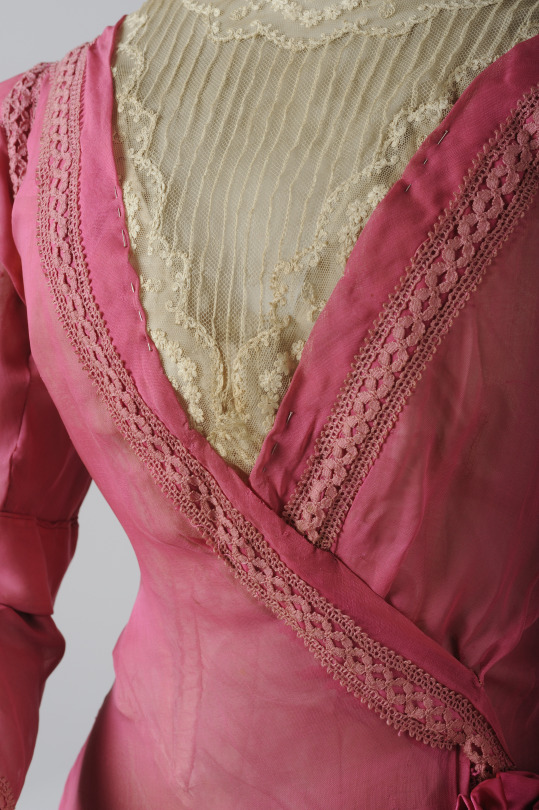

ab. 1910 Visiting or promenade dress by Rudolf Hoffmann & Co, Vienna
silk tamine, silk satin, cotton bobbin lace, cotton tulle, cotton tulle lace, silk taffeta, cotton tamine, whalebone, metal
(Wien Museum Karlsplatz)
437 notes
·
View notes
Note
I just woke up and opened tumblr to see this great discussion of Joe in lingerie (and someone forgetting that he says trans rights in the movie?? weird) and my question for u this morning is that if you claim joe likes super fine underwear, the kind that breaks if you look at it wrong, is he super duper careful with it or do they go thru a lot of expensive underwear?
okay this made me curious about the history of lingerie bc i feel like his feelings on it would be influenced by the evolution of undergarments made for sexy purposes. so! here’s a very brief, slightly inaccurate, mostly western-centric crash course on the history of lingerie:
lingerie is divided into two categories: hard and soft. hard lingerie - restrictive items made from bone/rigid plastic/etc - is used to shape the body, while soft lingerie - ur unstructured silks and satins and cottons - are there to accentuate or decorate what already exists
for a significant period of time soft lingerie (if u could even call it lingerie) was the status quo because it was practical and allowed people to move easily. these are ur loincloths, ur subligaculum, ur medieval dudou and breeches and chemises - base layers that served to keep the wearer warm, secure and/or modest. some sources place the invention of the modern bra around the 15th century, while others put it firmly in the 20th with the patent by caresse crosby. broadly speaking, though, bras weren’t a Thing for a v long time, and neither were undergarments made to look and feel sexy
then comes the 18th century, where europeans tightened their pussies and their undergarments by introducing stays, also known as whalebone corsets. these is the beginning of hard lingerie, and indeed lingerie as we understand it now; it was around this period that underwear became like. actually sexy. in the history of lingerie, chantal thomass notes that “while corsets were essential to maintaining both a woman's figure and her modesty, they also held an erotic allure” - these were clothes to fuck
[more under the cut bc i started researching in earnest]
now corsets were, as u’d expect, super expensive and became a cornerstone of the aristocratic dress code. they were made from whalebone! they were difficult to move in! they made u look dummy thicc!! no average working person was going to wear one, it just wasn’t practical. (i say person instead of woman because interestingly, it wasn’t unheard of for men to wear corsets up until the mid-19th century)
the corset began to fall out of fashion towards the late 19th/early 20th century for a few reasons, but the two biggest reasons were war and the first feminist wave. mid to upper class women were suddenly getting involved in physical labour and were like oh shit i can’t fucking move in this thing, can i get some uhhhh utilitarian garments. in conjunction with this shift in labour force, (some) women began to be treated like people. whack.
so in the 1910s we get soft lingerie coming back in the form of stuff like closed-crotch drawers and slips. by the 1920 the corset is declared dead, but it isn’t, but it kind of is? point is, people wanted sexy shit they could breathe in. the bra has just been officially invented and put into the oxford english dictionary in 1911, and the focus from then on out is to make them more comfortable.
what’s especially interesting around this period is that undergarments became a private thing. in j.c. flügel’s 1930 psychology of clothes, the attitude towards ~unmentionables~ was one of shame: “Garments which, through their lack of ornamentation are clearly not intended to be seen (such as women's corsets and suspenders, the coarser forms of underwear) when accidentally viewed produce an embarrassing sense of intrusion upon privacy that often verges on the indecent. It is like looking 'behind the scenes' and thus exposing an illusion.”
so what we have here is a perfect storm of paradoxical sexual repression and liberation, intra- and post-war periods where the stakes are high and no one has any fucking clue what’s going to happen next. along with social changes, the very fabric undergarments were being made from took on more forms - latex and nylon were invented in the 30s, lycra in the 50s - revolutionising what could be used to create soft lingerie. call of the whale hunting boys, it’s time to release microplastics into the ocean!!
by the 50s there’s definitely a subsection of underwear called lingerie, and it’s primary motivation is to be sexy. there are designers like ada masotti who make v high-end, luxurious pieces throughout the 60s, and despite a slight dip in interest, they manage to hang on long enough to see the lingerie revolution of the 1970s
while certainly not the only lingerie brand to boost the image of lingerie in the 70s, victoria’s secret is the most enduring brand from the period. it made lingerie accessible to more people by being ever so slightly cheaper than european brands like la perla
i’ve also got to give a shoutout to janet reger for leading the development of lingerie in the uk during the same period. according to her daughter and now-ceo aliza, “the brand started with my mother working from a room at home and my father taking samples to buyers in a small suitcase”. i just love that mental image of some dude wandering around with a briefcase full of panties
where was i? right. post-70s lingerie. while bra sizing had been a thing since the 30s, it really came into its own by the 90s when people wanted shit that actually fit them. the 90s was also a fun time for calvin klein, who took one look at mark wahlberg and went i want that twink obliterated in my ad, so now we have men’s lingerie!! kind of. idk i don’t really consider calvin klein lingerie
by the 2000s we have a whole heap of lingerie-specific brands like agent provocateur clearly signalling that sex(y clothes) sells. i’m way too tired to do a full sociological analysis on how lingerie advertising sell a concept more than the garments themselves so just imagine that’s here. also imagine there’s an actual discussion of the v quick rise and fall of the whale tail thong here as well.
ANYWAY, if ur still with me, my point is: lingerie began its life as a v expensive novelty, something to be treasured because that shit just didn’t come cheap. i feel like for the longest time, joe treated lingerie like his other fine clothing: with the utmost care and knowledge that if it was destroyed, it was gone forever - no replacements. he and nicky are so careful with their early lingerie and yeah, okay, maybe a few corsets get fractured along the way, but they were born into and continue to live in societies that value the longevity of clothing.
but then after all the turmoil of the early 20th century, its wars and political upheavals and the fresh trauma it brings, joe’s attitude shifts. lingerie is getting cheaper and he wants to feel good despite all the pain, so who cares if nicky tears his stockings with his teeth? they still have their favourite pieces, practically antiques by now, but it’s not uncommon for joe to come home with a handful of cheap, easily torn panties throughout the 70s and 80s.
at some point - i’m gonna say the early 2000s - they calm down. lingerie becomes precious again; they find handcrafted brands with quality fabrics and use them to their fullest potential. every other safe house has a stash of versace or dolce & gabbana nestled alongside handmade pieces from local artisans; their place in malta has a whole wardrobe full of garments that price in their thousands. nicky doesn’t care about the price; all that matters to him is that joe is happy and feels good.
........that being said they’ve definitely ruined more than a few pairs of shitty asos thongs
80 notes
·
View notes
Text
Okay so. I have researched the owner of this corset:

At the V&A [here], and here’s their description of it:
This corset was designed and made for the wedding of Mrs G.E. Dixon in July 1905. It is an S-bend corset, typified by the straight busk that compelled the pelvis backwards and the bust forwards into an angled ‘S’ shape. The corset offered some light control around the lower abdomen with strategically placed whalebones; however, since corsets rely on boning and strong fabrics for rigidity, the insertion of Mechlin-style machine lace and fine silk satin between the bones show that its function is largely decorative. The neckline is high, and the entire bust area is made of transparent lace decorated with silk flowers. At the bottom of the corset are four long suspender ribbons, attached with small gathered silk rosettes.
The object history: “Made for and worn by the donor, Marie Dixon, for her wedding, July 1905.”
So, we know her name is Marie, and she married someone called G. E. Dixon in 1905! It was made in the UK so let’s presume they lived in the UK, right?
And we know, July 1905. That brings us here -

George Edwin Dixon and Marie Katherine Harriett Bokenham were married on July 19th 1905, in Hanwell, Middlesex. She was 21 and a spinster (not previously married), and he was 42, twice her age and a widower.
Both their fathers were listed as gentlemen - Mr Bokenham was a civil engineer born in Peru in about 1856, who was mostly listed as “living on own means”, i.e., very rich, and Mr Dixon - well. I can’t find him. We know he ought to be Canadian, by G.E.’s 1911 census, but as I can search (that’s UK, USA and Canada, really), I can’t find a George/Geo./Edwin/G. E. Dixon/Dickson/Dickinson etc born to a a man of the same name within ten years of George’s reported birth who might reasonably be described a “gentleman”. There were several farmers in Canada, tho. And a shoemaker. So, I’m thinking, George here lied and bigged himself up a bit for his new wife’s family - given they were reasonably well-off, and to make the age difference a little more palatable, perhaps.
George is listed as a “Doctor of Medicine”, which is also shown on the 1911 census
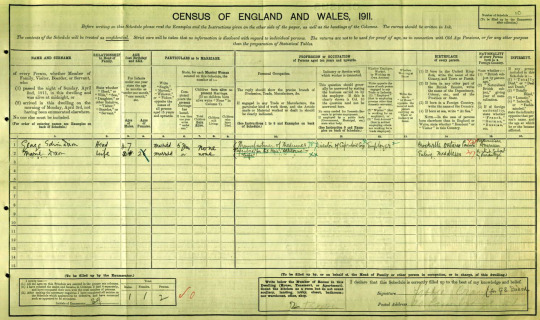
Here, it’s shown that they’ve been married 5 years, which we know, and that they are now 47 and 26, so nobody fudged facts (or at least dates, anyway) on the marriage record, which is always good to see. George is now the director of a company making “capsuloids for the hair: antitoxine. cicfa”. A bit less fancy, maybe, than “doctor of medicine”, which lends itself to my theory.
More new information is that though they only have two rooms (we count the kitchen as a room, but not the scullery, landing, lobby, closet or bathroom, according to the little box for writing that information in), they do live in Hyde Park, at 20 Cambridge Street (what is now Cambridge Place, I assume after the bombing in the Blitz). They share with their landlady, a Mrs Jessie Craig from Glasgow, who has 9 rooms (and 2 sons and a live-in domestic servant called Lily Ford), and a retired navy lieutenant (”Lieut R N Retired”) by the name of Guy Renton Livingstone, who is Irish and the secretary of a golf school (that’s a thing?) and occupies one room.
A large house, tho the Dixons only have a small part of it.
I do imagine somewhat, though, that this maybe isn’t quite what Marie had in mind when she married a doctor - but you never know, perhaps they were in love or something, I can’t go back in time to ask them, and maybe I’m being far too cynical.
What I have found, though, is they went to America!
From their “arriving passenger” records, I have a description of them, their address in America, their address in England, George’s occupation, and how long they intended to stay.
So, in 1921, George was 58 years old, 5ft half an inch, with a fresh complexion, grey hair and blue eyes, and was a chemist. He is also listed as having visited the US in 1892.
Marie was 38, 5ft 5, with a fresh complexion, brown hair and brown eyes.
They lived in Marlow, Bucks, in the UK, but they intended to stay permanently in the USA - their American address as listed was 14 East 50th Street New York, tho I don’t know much at all about New York as to tell you about that, tbh, but I do know from Google Maps, it’s just near Madison Ave and 5th Ave, which to me sounds very fancy.
Above the “permanent”, in pencil, there’s a note that says “2 mo.”, and they did not intend to become citizens.
I’m not sure if they did only stay their intended 2 months, or what happened, but the next record I have is that they return to England in April 1928, 1st class to Bristol. The “incoming passenger” list gives much less information, but I know that George is still the director of a company, and they are going to live at Cedar Cottage in Marlow.
Here it is!

George dies, unfortunately, in September that same year - maybe they returned to England as he was sick, I don’t know. His effects were over £30k, which is over £1.3 million today.
From the accession number on the corset, I think this is when Marie donated her wedding corset to the V&A.
Marie, however, didn’t much hang around, shall we say.
She went to India, and married a man called Richard Valentine Read on 6th December 1929, the very same year she was widowed.
I haven’t a description of Richard, because I can’t access his war records properly, but I know his middle name was Valentine because he was born on Valentine’s Day in 1892 - he was four years younger than Marie. His father was a member of the London Stock Exchange, and Richard was a colonel in the British military (I know he had shore leave in Puerto Rico in 1939) - in 1925, leaving Liverpool on a round cruise to Lisbon and the Canary Islands, he’s listed as “Capt R V Read, DSO MC” which denotes him as someone of Distinguished Service who earned the Military Cross.
They went to America in early 1933 - to Santa Barbara, California, this time, to visit a Mrs Carrington for a week, at Villa Riposte.
Aha, here we have a description of them both. Marie is 5ft6, now with grey hair and brown eyes, at 47 years old. Richard is 6ft4, with grey hair and blue eyes, at 41 years old. Their last address is in “Kawalpiudi”, India - I rather think that’s a terrible spelling of Rawalpindi, which is now Pakistan - but their American visas were issued in London.
Oh, their incoming New York papers have more description info.
Marie is “sallow” with brown hair and brown eyes, and Richard is “fair” with light brown hair and grey eyes, a tattoo on his right forearm and a war scar on his right shoulder.
I wonder at the difference in their descriptions between December 1932 (New York) and January 1933 (Los Angeles), but there’s no solving that I spose. It’ll just be the different people who took their details down.
They were quite jetsetters actually - I assume, in some way it was with Richard’s job, since he’s listed once as an attaché - they went to Genoa in February 1935, Yokohama in August 1936, New York in 1938 - though Richard went alone to Marseilles in 1935, and to Palestine in 1937.
I can’t find any record following these, or of Marie’s death - there are too many Marie Read’s about, and she might’ve been recorded as Mary, as well, so I can’t narrow it down, and there’s nothing I can find in the British papers - I do know that Richard remarried in 1953, though, and died at sea in 1964. He lived in Fredonia NY, and left £6000 to his wife Joyce.
So! I haven’t quite the whole story, I don’t think, but a lot of it at least, which is something!
It’s a shame I couldn’t find photos or anything, but I found quite a bit I reckon.
#either way marie had fancy clothes#and very sexy (for 1905) wedding night lingerie!#corset#corsetry#lingerie#history#research
15 notes
·
View notes
Quote
Novigrad, I tell you, is the capital of the world. Almost thirty thousand dwellers, Geralt, not counting travellers; just imagine! Brick houses, cobbled main streets, a seaport, stores, shops, four watermills, slaughterhouses, sawmills, a large manufactory making beautiful slippers, and every conceivable guild and trade. A mint, eight banks and nineteen pawnbrokers. A castle and guardhouse to take the breath away. And diversions: a scaffold, a gallows with a drop, thirty-five taverns, a theatre, a menagerie, a market and a dozen whorehouses. And I can’t remember how many temples, but plenty. Oh, and the women, Geralt; bathed, coiffured and fragrant; those satins, velvets and silks, those whalebones and ribbons…
Jaskier; Sword of Destiny: Eternal Flame (Andrzej Sapkowski)
Industry! Culture! Women! Clothes!
3 notes
·
View notes
Text

• Wedding dress.
Date: 1840
Place of origin: United States
Medium: Silk satin, cotton lining, whalebone, metal hook & eye closures.
#19th century fashion#19th century#19th century dress#dress#fashion history#history of fashion#fashion#wedding dress#united States#1840
218 notes
·
View notes
Text


Evening dress, ca.1895-1900. London.
Festa & Co (makers).
Silk satin and grosgrain trimmed with tulle, lined with cotton, whalebone and starched gauze
Etiquette dictated that women of society vary their evening dress according to the occasion. Dresses like this one with uncovered arms and neck were known as 'Full dress'. They were suitable for dances, balls, dinners and visits to the opera. Ladies of high rank usually wore gowns with longer sleeves and higher necklines at less formal venues such as the theatre.
The location of Festa & Co's establishment at Carlos Place was in Mayfair, at the heart of London's court dressmaking industry. Their clientele would have been drawn from the height of the aristocracy, with London houses nearby. The house of Worth and other famous couturiers were also close neighbours.
1 note
·
View note
Photo

#waybackwednesday #vintagewednesday C1870s Black silk satin corset from the private collection of Stephanie Selmayr shown at the @conferenceofcorsetry back in August. . The corset is stiffened with corded panels used vertically in the front sections over the bust and horizontally over the hips. . Cording was a popular method often used in addition and as an alternative to whalebone. Cording was the application of sandwiching twisted cord (usually hemp, cotton or paper) between two layers of fabric. . As in the case of this example cording was also viewed as a design detail. The corded panels provided suppleness to the gament whilst still controlling the wearer's figure. . >> follow @laced_unlaced for more historical corsetry posts #corsetry #corsethistory #historicalcorset #antiquecorset #costume #antiqueclothing #victorianfashion #victoriancorset #flossing #authenticcorset #fashionhistorian #lacedunlaced #victorianstyle https://www.instagram.com/p/B5FEX5RgKin/?igshid=10ua1hpcnbxik
#waybackwednesday#vintagewednesday#corsetry#corsethistory#historicalcorset#antiquecorset#costume#antiqueclothing#victorianfashion#victoriancorset#flossing#authenticcorset#fashionhistorian#lacedunlaced#victorianstyle
1 note
·
View note
Note
Ok so I’m looking into getting a corset or two to wear daily, because of back pain from my bad posture, but I’m not good at making myself stay straight up. Do you have any suggestions to what kinds to look out for or whether to buy a premade or sew one myself?
So my first piece of advice is to do regular ab exercises to keep those muscles from weakening or growing too dependent on the corset. It was one of the few health problems attributed to daily corset wear back in the 19th century that is a legit concern. It won’t harm you per se, but apparently it can result in progressive discomfort whenever you go without your corset. Easily remedied with proper care, but do take note of it.
Look for a steel-boned corset. Plastic boning can warp out of shape very easily and cause pain/discomfort if it pokes you or compresses where it shouldn’t. The exception is German faux whalebone, but very few places sell ready-made corsets with that sort of boning and those that do are expensive, custom historical boutiques like RedThreaded. Measure yourself carefully and be sure you’re getting the best fit.
A good corset can be expensive, but resist the temptation to look for a cheaper alternative. Anywhere from $70 to $500 USD is a good range, generally speaking. Invest a quality piece and you’ll get years of comfortable wear out of it. Definitely buy premade to start; making corsets is devilishly tricky and those mistakes we all make at first can translate into physical discomfort.
I recommend Orchard Corset as a great place for starter corsets. To replace a bra, you’ll want an overbust or demibust model. If chest support isn’t a factor, any corset will do, but wearing a bra with something that covers even part of your chest can get uncomfortable fast. Their Corsets 101 video series has lots of helpful info for beginners, too.
Always wear a chemise, tank top, or other liner under your corset. You’re in for a jaunt through the Wonderful World of Chafing otherwise. Many people recommend silk or satin-finish corsets for stealthing (wearing corsets under your modern clothes), but I find it’s a matter of personal preference. Lucy’s Corsetry on YouTube has plenty of videos on that and other corset-related subjects.
Finally, don’t lace too tightly too fast. All the other resources will tell you that, but I feel it bears repeating. And repeating. And repeating yet again. Especially if you’re corseting for posture help. Lace for comfort, and if that means no reduction at all, that’s perfectly fine.
Hope this helps!
30 notes
·
View notes
Text
What are corset tops made of?
Corset tops can be made from various materials, depending on the desired level of support and comfort. Traditionally, corset tops were made from stiff fabrics such as silk, brocade, or satin and were reinforced with boning made from materials such as whalebone or steel.
Today, many corset tops are made from more flexible materials such as cotton, spandex, or nylon and may use plastic or synthetic boning instead of traditional materials.
The material used for a corset top can significantly impact its comfort and effectiveness. Stiffer fabrics and boning may provide more shaping and support but can also be more uncomfortable to wear for extended periods.
Softer materials may be more comfortable but may provide less shaping or support.
0 notes